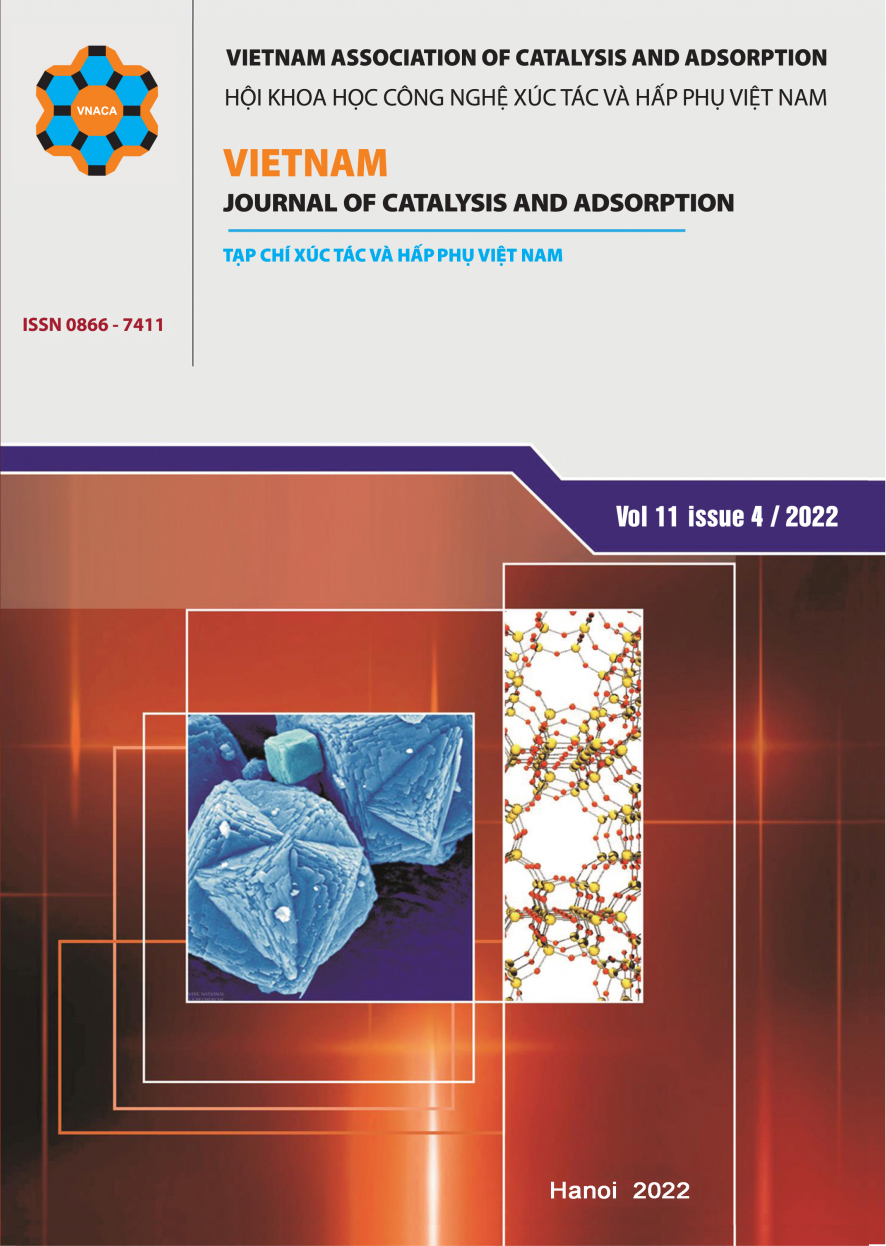Research on synthesis and electrochemical properties of MIL-53 /rGO materials and application of electrochemical sensor development to detect Cd2+ ions in aqueous solutions
DOI:
https://doi.org/10.51316/jca.2022.080Keywords:
MIL-53/rGO, heavy metal ions, metal organic framework, Electrochemical sensorAbstract
MIL-53/rGO material has been synthesized in a 2-step process on the basis of metal organic framework material of MIL-53(Fe) and reduced graphene (rGO). Material characteristics were studied through XRD, SEM, and electrochemical DPV measurements. Electrochemical sensor based on nanocomposite MIL-53(Fe)/rGO material has been developed, showing outstanding advantages including the ability to detect directly Cd2+ ions in aqueous solution, fast detection time and sensitivity. quite tall. The relationship between the sensor output signal (Ipeak) and the concentration of Cd2+ ions in the range 1 to 9 μM is linear, having the square of the correlation coefficient R2 = 0.9705.
Downloads
References
Q. Sun, D. Yuan, Z. Chen, M. Megharaj and R. Naidu, Microchimica Acta. 169 (2010) 41-47. https://doi.org/10.1007/s00604-010-0311-7
E. Bakkaus, R. N. Collins, J.-L. Morel and B. Gouget, J. Chromatogr. A. 1129 (2006) 208-215. https://doi.org/10.1016/j.chroma.2006.07.004
B.-B. Guan, Q. Li, Y.-T. Xu, L.-H. Chen, Z. Wu, Z.-L. Fan and W. Zhu, Inorg. Chem. Commun. 122 (2020) 108273. https://doi.org/10.1016/j.inoche.2020.108273
X. Wang, Y. Qi, Y. Shen, Y. Yuan, L. Zhang, C. Zhang and Y. Sun, Sensors and Actuators B: Chemical. 310 (2020) 127756. https://doi.org/10.1016/j.snb.2020. 127756
S. Duan and Y. Huang, J. Electroanal. Chem. 807 (2017) 253-260. https://doi.org/10.1016/j.jelechem. 2017.11.051
D. Feng, P. Li, X. Tan, Y. Wu, F. Wei, F. Du, C. Ai, Y. Luo, Q. Chen and H. Han, Anal. Chim. Acta. 1100 (2020) 232-239. https://doi.org/10.1016/j.aca.2019. 11.069
Z. Hu, B. J. Deibert and J. Li, Chem. Soc. Rev. 43 (2014) 5815-5840. https://doi.org/10.1039/C4CS00010B
F.-Y. Yi, D. Chen, M.-K. Wu, L. Han and H.-L. Jiang, ChemPlusChem. 81 (2016) 675. https://doi.org/ 10.1002/cplu.201600137
M. Kaur, S. K. Mehta and S. K. Kansal, Mater. Chem. Phys. 254 (2020) 123539. https://doi.org/10.1016/ j.matchemphys.2020.123539
H. V. Tran, H. T. M. Dang, L. T. Tran, C. Van Tran and C. D. Huynh, Adv. Polym. Tech. 2020 (2020). https://doi.org/10.1155/2020/6279278
L. Hou, Y. Qin, T. Lin, Y. Sun, F. Ye and S. Zhao, Sensors and Actuators B: Chemical. 321 (2020) 128547. https://doi.org/10.1016/j.snb.2020.128547
N. Li, J. Chen and Y.-P. Shi, Talanta. 201 (2019) 194-203. https://doi.org/10.1016/j.talanta.2019.04.002
M. Shahabi Nejad, S. Behzadi and H. Sheibani, Appl. Organomet. Chem. 33 (2019) e4804. https://doi.org/10.1002/aoc.4804
R. Liang, F. Jing, L. Shen, N. Qin and L. Wu, J. Hazard. Mater. 287 (2015) 364-372. https://doi.org/ 10.1016/j.jhazmat.2015.01.048
Downloads
Published
Issue
Section
How to Cite
Share
Funding data
-
Trường Đại học Bách Khoa Hà Nội
Grant numbers T2020-PC-217










